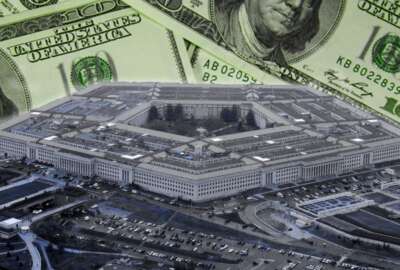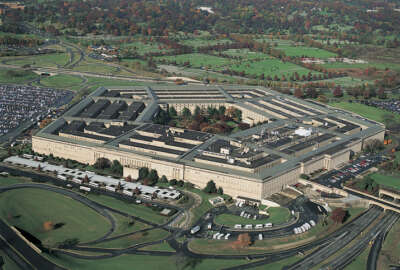Where does waste, fraud and abuse in the military stand after Afghanistan?
A new report says defense companies are reaping the benefits from building an ever-growing military system.
The closing of the war in Afghanistan is stoking new concerns about waste, fraud, abuse and industry pressure in Defense Department spending.
A new study from the Center for International Policy (CIP) and Brown University is shedding light on squandered dollars post-9/11 and how the defense industry may be influencing policy to beef up the military-industrial complex for the next phase of threats.
In the wake of the terrorist attacks, the United States put $14 trillion into the military – funding private contractors for security, weapons suppliers and defense companies to rebuild war-torn countries.
“Some of these corporations earned profits that are widely considered legitimate. Other profits were the consequence of questionable or corrupt business practices that amount to waste, fraud, abuse, price-gouging or profiteering,” William Hartung, senior adviser at CIP and author of the study wrote. “The Pentagon’s increasing reliance on private contractors in the post-9/11 period raises multiple questions of accountability, transparency, and effectiveness. This is problematic because privatizing key functions can reduce the U.S. military’s control of activities that occur in war zones while increasing risks of waste, fraud and abuse.”
The Special Inspector General for the Reconstruction of Afghanistan found billions of dollars of waste by corporations in the form of buildings that were never used, faulty equipment, overcharging and more. That’s not to mention acquisition programs outside of wartime spending that the Project on Government Oversight found are going over cost and schedule.
Hartung posits that the outsized influence of defense contractors manifested in everything from the Pentagon’s receipt of the lion’s share of the federal discretionary budget to the supply of excess military equipment of state and local law enforcement.
“Five companies received over $286 billion in contracts in 2019 and 2020 alone,” Hartung wrote. “From 2001 to 2020 these five firms alone split over $2.1 trillion in Pentagon contracts.”
In an interview with Federal News Network, Hartung said “because these firms have almost a near monopoly over the particular lines of production they’re involved in, they influence things like price, performance and the ability to bargain a good deal for taxpayers. This is problematic.”
To the Pentagon’s credit, it has been taking major steps to expand its industrial base the past several years as defense contractors have become more insular. DoD is taking note of the innovation happening in other private sectors and trying to bring them into the fold.
“Prime contractors were built around a group of approximately three dozen large conglomerate firms with substantial capacities in both advanced civil and military technologies and markets,” Michael Griffin, former Defense undersecretary for research and engineering, said in late 2019 as he set up a task force focused on expanding the industrial base. “Microprocessors, high-performance jet engines, space systems and technology, advanced materials, etc., developed in the defense sector ‘trickled down’ into the civil sector.”
Today the technologies are taken from a global civilian scale and trickle down to the defense sector. The defense sector is continuing to shrink as the number of prime contractors declined from 30 to five between 1992 and 2007.
Griffin feared that defense companies are isolated on a national security “island” while operating a sea of commercial information-driven firms on a global basis.
Wes Hallman, vice president for strategy and policy at the National Defense Industrial Association (NDIA), said DoD and industry welcome in entrants into the industrial base and that NDIA is also concerned with the consolidation of the base.
However, he noted that all consolidation is not created equal.
“Consolidation can be in the eye of the beholder,” he said. “There is a big difference between a horizontal and vertical merger. We’ve gotten to fewer and fewer companies that can provide out big ticket items like ships, aircraft, and that’s a concern.”
But, smaller companies are no longer getting a lot of funding from the government and are instead turning to venture capitalists.
Hallman said he is less concerned about bigger companies eating up smaller innovative ones, because that innovation still makes it into the base.
Looking to near-peer competition
Hartung claims that defense contractors are now benefiting from the military’s buildup to counter near-peer competitors like China and Russia.
“The military threat from China has been much exaggerated,” he said. “The United States spends about three times on our military than China does, our nuclear stockpile is 13 times as large and we have a more capable Navy.”
He also pointed out that the United States has a more robust alliance system, while China does not.
“The challenge from China is more political and economic and diplomatic, and also there are areas where we have no choice but to cooperate in dealing with climate change, preventing future pandemics and trying to put the world economy on a more balanced basis,” Hartung said. “A lot of this is coming denizens of the military industrial complex and not just from old cold warriors. There was a National Defense Strategy commission mandated by Congress, which has called for a 3-to-5% real increase in Pentagon spending for as far as the eye can see every year. In that commission, more than half of the members work for defense contractors.”
House Armed Services Committee Chairman Adam Smith (D-Wash.) has expressed his displeasure with the defense strategy as well.
“Our current National Defense Strategy is too big, too ambitious and too unrealistic in terms of what our needs are. I also feel very strongly the U.S. must be actively engaged in the world to create a more peaceful and prosperous world,” he said in April. “We don’t have the people to meet that many different needs, to fight that many battles at the same time. We’re sort of perpetually chasing our tail.”
He noted that the U.S. needs to rely more on allies and have enough might to “bloody” China’s nose alone.
Hallman disagreed.
“This is not a Cold War environment where you had one big actor in the soviet union,” he said. “Right now, we’ve never had a more dangerous or complex environment. It looks more like the 1910s than the 1950s. In the 1910s you had multiple major powers vying for influence.”
He pointed out that DoD is not always getting the 3-to-5% increases
Hallman said China is a large threat in the sense that whatever it does it will influence the international community and how the United States operates in the world.
Hartung said one of the biggest issues amping up the China threat, and therefore more military spending, is the revolving door.
“You have hundreds of people every year, going back and forth between government and the Pentagon, the Congress, National Security Council, all the agencies that decide on our defense policy, and equally importantly, our Pentagon spending,” he said.
Defense Secretary Lloyd Austin was on Raytheon’s board, as was the previously confirmed Defense Secretary, Mark Esper.
Hallman said he thinks the problem is bigger in theory than in practice.
“I see a growing issue of a lack of experience in senior levels,” he said. “Profit shouldn’t be a dirty word. Companies are beholden to their shareholders. You want folks in government to understand what it takes for industry to survive.”
He said DoD officials with industry experience have an understanding that can create win-win scenarios for the taxpayers and companies.
Copyright © 2025 Federal News Network. All rights reserved. This website is not intended for users located within the European Economic Area.
Scott Maucione is a defense reporter for Federal News Network and reports on human capital, workforce and the Defense Department at-large.
Follow @smaucioneWFED







